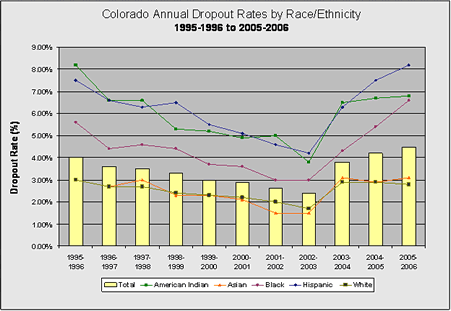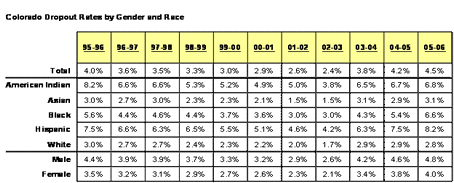You are here
2005-2006 Dropout Data
Students attending Colorado’s public schools during the 2005-2006 school year had a dropout rate of 4.5 percent. This was a 0.3 percentage point increase from the 2004-2005 school year (4.2 percent) and a 0.7 percentage point increase from the 2003-2004 school year (3.8 percent).
Dropout Rate Notes
Beginning in 2005, CCR 301-67 - “Rules for the Administration of Colorado Data Reporting for School Accreditation” - required Colorado’s school districts to obtain adequate documentation of transfer for all students who transfer from the district to attend a school outside the state or country, a private school, or a home-based education program. Adequate documentation is defined as an official request for academic records from the student’s new school or, in the case of a home-based education program, a signed form from a parent or legal guardian. If the district cannot obtain this documentation, the student must be reported as a dropout. The quantitative effect of this provision on the dropout rate cannot be calculated precisely. However, by applying a conservative estimate that ten percent of all seventh through twelfth graders reported as dropouts in the 2005-2006 school year would have been counted as transfers rather than dropouts under the old methodology, the state dropout rate would decrease by 0.5 percentage points. Districts serving highly mobile student populations were potentially affected by this provision to a much greater degree.
Dropout Rates for the 2005-2006 School Year
District Level Data
- Dropout Rates by Gender, Instructional Program Service Type, Race/Ethnicity, and District (Text)
- Dropout Rates by Gender, Instructional Program Service Type, Race/Ethnicity, and District (XLS)
- Dropout Rates by Gender, Instructional Program Service Type, Race/Ethnicity, and District (PDF)
- Dropout Rates by Gender, Grade, Race/Ethnicity, and District (Text)
- Dropout Rates by Gender, Grade, Race/Ethnicity, and District (XLS)
- Dropout Rates by Gender, Grade, Race/Ethnicity, and District (PDF)
School Level Data
- Dropout Rates by Gender, Instructional Program Service Type, Race/Ethnicity, and School (Text)
- Dropout Rates by Gender, Instructional Program Service Type, Race/Ethnicity, and School (XLS)
- Dropout Rates by Gender, Instructional Program Service Type, Race/Ethnicity, and School (PDF)
- Dropout Rates by Gender, Grade, Race/Ethnicity, and School (Text)
- Dropout Rates by Gender, Grade, Race/Ethnicity, and School (XLS)
- Dropout Rates by Gender, Grade, Race/Ethnicity, and School (PDF)
Copies of these reports may be obtained by contacting, Data & Research Unit, Colorado Department of Education, 201 East Colfax Avenue, Room 508, Denver, CO 80203. Our office hours are Monday through Friday, 8:00 a.m. to 5:00 p.m. Please contact Peter Fritz at (303) 866-6175 for information on how this data is collected.
Dropout Rates – Historical Overview


Questions and Answers About Colorado Dropout Rates
Who Is Considered a Colorado Dropout? By Colorado law, a dropout is a "person who leaves school for any reason, except death, before completion of a high school diploma or its equivalent, and who does not transfer to another public or private school or enroll in an approved home study program." A student is not a dropout if he/she transfers to an educational program recognized by the district, completes a G.E.D. or registers in a program leading to a G.E.D., is committed to an institution that maintains educational programs, or is so ill that he/she is unable to participate in a homebound or special therapy program. Students who reach the age of 21 before receiving a diploma or designation of completion (“age-outs”) are also counted as dropouts.
Under what Circumstances is a Student Reported as a Transfer? For purposes of the dropout rate, a ‘transfer’ is a student who enrolls in another school that awards a diploma, or who enrolls in a GED program, or enrolls in a home-based education program (home school) pursuant to 22-33-104.5. A student is considered a transfer to another district or educational program if the receiving school or program sends an official request for the student's records, or, if the student transfers to a home-based education program, a signed notification from the student’s parent or guardian can serve as official documentation of transfer.
What If a Student Just Disappears? A student who disappears from school is considered a dropout unless the original district can obtain official documentation that the student transferred to another educational program.
What Is the Dropout Rate? The Colorado dropout rate is an annual rate, reflecting the percentage of all students enrolled in grades 7-12 who leave school during a single school year. It is calculated by dividing the number of dropouts by a membership base which includes all students who were in membership any time during the year. In accordance with a 1993 legislative mandate, beginning with the 1993-94 school year, the dropout rate calculation excludes expelled students.
Dropout Rate Calculation:
Number of dropouts in year X
Number of students part of same membership base at any time during year X
Can the Dropout Rate Be Multiplied by Four to Find Out How Many Students Drop Out Over the Four Years of High School? No. The dropout rate is an annual rate only. It is not statistically valid to simply multiply the annual rate by four to find out how many students dropped out during high school. The graduation rate, however, provides a measure of how many students completed graduation requirements.
Can a Student Drop Out More Than Once? How Does That Affect the Annual Dropout Rate? Some students have a pattern of dropping out and returning to school several times before they either graduate or drop out and do not return. In the state reporting system, a student is counted as a dropout only once within a given reporting period (i.e., from July 1 through June 30). However, if a student drops out during one school year, then returns to school the following year and drops out again, he/she will be counted in the dropout rate two years in a row.
Are Students Who Transfer to a GED Program Counted as Dropouts? No. For the purposes of the dropout rate, students who enter a GED program not run by a Colorado school district are counted as transfers and not as dropouts. These students will negatively affect the graduation rate for the district, school, and cohort they last attended, because they will be added to the graduation base (or graduation rate denominator) whether they receive a GED certificate or not.
How Valid are Colorado's Dropout Rates? The Colorado Department of Education provides definitions, guidelines, and training regarding the proper procedures for identifying and reporting dropout statistics. The data are edited and screened upon receipt and a summary document with the calculated rates is returned to the district for verification. In submitting the data to the state, each superintendent signs an assurance that the district has followed the required procedures.
How are Dropout Data Reported? Dropout data are reported annually to the Department by Colorado school districts. Dropout data are collected for grades 7-12, by school building and by district. Data are reported separately by gender, ethnicity/race, Instructional Program Service Type, and grade level of students.
Definitions of Terms Used in the Dropout Rate Reports
Instructional Program Service Type (IPST): Services provided by schools and/or districts for students identified as belonging to one or more of the categories below:
Students with Disabilities: Students who have been formally identified as having physical or health conditions that may have a significant impact on the student’s ability to learn and therefore warrant placing the student on an Individual Educational Program (IEP).
Limited English Proficient: This designation encompasses all students identified as either non-English proficient or limited English proficient. Non-English proficient is defined as a student who speaks a language other than English and does not comprehend, speak, read, or write English. Limited English proficient is defined as a student who comprehends, speaks, reads, or writes some English, but whose predominant comprehension or speech is in a language other than English. Districts must provide language services to all limited English proficient students.
Economically Disadvantaged: Student qualifies for either the free or reduced lunch program. The Federal National School Lunch Act establishes eligibility for the reduced price lunch program for families with income up to 185 percent of the federal poverty level (in 2005, this amount was $35,798 for a family of four). Families with income up to 130 percent of the federal poverty level qualify for the free lunch program (in 2005 this amount was $25,155 for a family of four).
Migrant: Students enrolled in a specially designed program for children who are, or whose parent or spouse is a migratory agricultural worker, and who, in the preceding 36 months, in order to obtain, or accompany such parent or spouse in order to obtain, temporary or seasonal employment in agricultural work has moved from one school district to another.
Title 1: Students that are identified by the school as failing, or most at risk of failing, to meet the State’s challenging student academic achievement standards on the basis of multiple, educationally related, objective criteria established by the school.
Homeless: According to the McKinney Act, a “homeless individual”: lacks a fixed, regular, and adequate nighttime residence.
Gifted and Talented: Students who have been formally identified, using district wide procedures aligned with CDE guidelines, as being endowed with a high degree of exceptionality or potential in mental ability, academics, creativity, or talents (visual, performing, musical arts, or leadership.



Connect With Us




